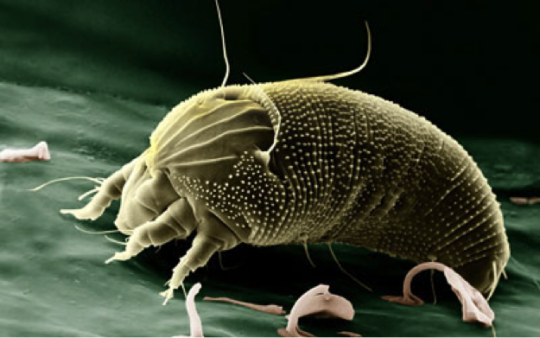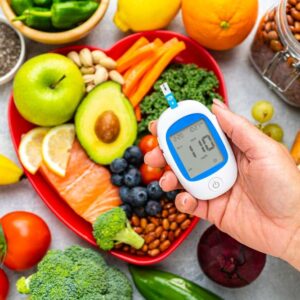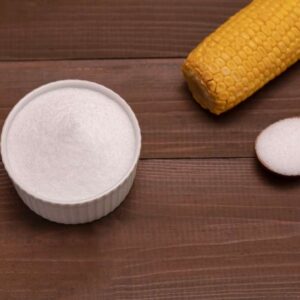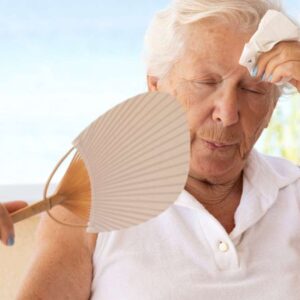
This Type of Bug Is In Your Bed [Photo]
- Discover how millions of uninvited bedfellows are ruining your health
- Got asthma? This bug may be to blame. Find out more…
- Plus, a few easy ways to keep these dirty squatters away.
Dear Living Well Daily Reader,
“Oh, you’re not sick because they are in your bed. You’re sick because of what they are doing in your bed…”
For the past three days, I’ve woken up with itchy, watery eyes, a runny nose, and endless sneezing.
You see, I’m in Florida and staying in a foreign bed. But due to these symptoms, I haven’t gotten a whole lot of rest.
Fortunately, I had a chance to catch up with a respiratory therapist I used to work with. She informed me that my symptoms were likely caused by the byproduct of an uninvited bedfellow.
This information confused me greatly, as I’m staying in my family’s extremely tidy house, not a questionably clean hotel.
But what was more shocking… my reaction wasn’t to these pests, but to what they were leaving behind.
The scary part is these bugs are EVERYWHERE. Including your bed.
I’ll tell you how I know that in just a minute. And we will share a few tips on how to rid your bed of these filthy invaders.
First, let’s find out more about who’s in your bed…
![]() Soiling Squatters
Soiling Squatters
Dust mites — naturally occurring microscopic pests that feed on dead human skin cells and are responsible for the some of the most common indoor allergens.
Yet the mere presence of these tiny pests won’t make you sick. It’s what they are leaving behind that’s ruining your health — their feces!
That’s right, I’m sleeping in and getting sick from dust mite poop.
And guess what? You probably are too.
According to the American Lung Association, four out of five American homes have beds with dust mites.
But they may not be just in your bed. Millions of dust mites could be hiding (and pooping) in your curtains, carpets, and furniture.
However, since they burrow into your bed, your greatest exposure comes during sleep.

Yum! Dead human skin cells!
Source: achooallergy.com
My reaction to dust mites was very mild. For some folks, dust mites trigger severe asthma attacks, chronic sneezing and coughing, and facial pressures. In some cases, dust mite exposure can even cause asthma.
Luckily, there are a few ways to evict these soiling squatters.
![]() Be Dust Mite Free
Be Dust Mite Free
Since dust mites absorb moisture from the air instead of drinking water, humidity is the most significant factor in dust mite control. If you live in a humid climate, getting a dehumidifier is one way to reduce moisture in the air. There are several types available, but a free-standing unit is a good way to get started. Click here to check out a unit by Haier.
Also, be sure to open your windows on dry days in order to reduce moisture in your home.
Another way to control the population is to reduce their habitats. Throw out any nonessential textiles from your home. Things like curtains, area rugs, decorative pillows, and stuffed animals can increase dust mite populations, so it’s best to pitch them when you can. If you can’t toss them, wash them weekly in hot water to kill off existing mites.
Since you can’t wash your mattress weekly, getting a dust mite mattress cover is a good option. These specially designed mattress covers will keep dust mites from burrowing into your mattress. Click here to check out a cover by Eco Living Friendly
Live well,

Natalie Moore
Managing editor, Living Well Daily
Sources
[1] Dust Mites
Written By Natalie Moore
Natalie Moore is a dedicated health researcher with a passion for finding healthy, natural, and science-based solutions. After a decade of direct healthcare experience in western and natural medicine, she was involved in public health research before joining Living Well Daily.
View More Free Articles
This Sleep Mistake Is Doubling Your Disease Risk
Think your inconsistent bedtime is just a harmless habit? Think again. New research reveals that going to bed at different times each night isn’t just making you tired—it could be dramatically increasing your risk of serious diseases. But the key to making sure poor sleep doesn’t derail your health goals likely isn’t what you think…....
Stop Obsessing Over Diet Trends
Can we stop with the endless diet debates already? Every other week there’s a new headline shouting about which diet is best for weight loss, heart health, or diabetes. Paleo, keto, low-carb, high-protein… it’s exhausting. And now, a new meta-analysis is out comparing the Mediterranean diet, the DASH diet, and something called AHEI (that’s “Alternative...
A New Reason to Ditch Processed Junk
If you’ve ever walked the inside aisles of your local grocery store and thought, “This is all just junk,” your instincts were spot on. A new study published in the journal Thorax just added another red flag to the list of dangers linked to ultra-processed food—a 41 percent higher risk of lung cancer. That’s right....
When Being Winded on Stairs Is Serious (And When It Isn’t)
I had an athlete visit me recently because he experienced shortness of breath while climbing stairs. He is in great shape, so he was worried about what it might mean. “Doc,” he said, “I run five miles three times a week. Why am I huffing and puffing after two flights of stairs?” His concern is...
Study EXPOSES Hidden Danger Lurking in Your Car
We think of our homes and cars as safe havens. But according to a startling new study, they may be flooding your lungs with microscopic plastic particles—every single day. Researchers in France recently found that adults inhale an average of 68,000 microplastic particles daily from indoor air alone. To put that in perspective, that’s about...
Mailbag: Is Modern Food Making You Snore?
“What can cause snoring, and is there a way to correct this issue?” —Seeking Silence Hi Seeking, Snoring happens when the soft tissues in your throat relax and vibrate as air passes through during sleep. While several factors can cause snoring—from sleep position to nasal congestion—I want to share one trigger that might surprise you....
Simple Food Swap SLASHES Dementia Risk 28%
Let’s be honest… who would jump at the chance to cut their dementia risk by 28 percent. And no, you don’t need to run marathons, survive on broccoli, or learn to play the zither (whatever that is) to make it happen. All it takes is one easy swap—something that’s probably already in your refrigerator. Researchers...
This SMART Floss Exposes Hidden Health Danger
Scientists have created dental floss that doesn’t just clean between your teeth—it also tracks your stress while you’re flossing. Now, I know what you’re thinking… “Great—now even flossing is going to stress me out by telling me how stressed I am.” But this fascinating new tool from Tufts University could be a game-changer for understanding...
Is This "Safe" Sweetener Damaging Your Brain?
The headlines are alarming… “Popular Sugar Substitute Linked to Brain Cell Damage” and “Erythritol Could Damage Critical Brain Barrier” are just two of the dozens I’ve spotted recently. But before you toss every sugar-free product in your pantry, let’s take a closer look at what this study actually shows—and what it doesn’t. The latest research...
This Summer Threat Could SPIKE Your Blood Sugar
Picture this… It’s another scorching hot summer day. You crank up the air conditioning while watching the weather forecast, which predicts yet another “record-breaking” heat wave. It’s starting to feel like just another miserably uncomfortable summer. But what you might not realize is that—if you have diabetes—those rising temps could do far more damage to...









